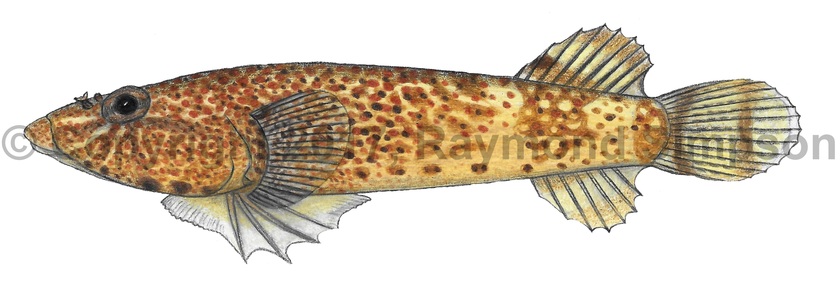
Common Name
Riverine Clingfish
Year Described
Lacepede, 1800
Identification
Dorsal Fin: 8-10
Anal Fin: 6-8
Pectoral Fin: 19-22
Head depressed and wide. Body tapering and becoming laterally compressed posteriorly. Sensory papillae on head poorly developed (none on top lip or snout). Eyes relatively large. Rear nostril with two prominent flaps. Mouth terminal and small. Top lip broad at front, thin on sides. Top jaw with 4-5 pairs of incisors at front, a patch of teeth behind, and a row of teeth on either side. Lower jaw 5-7 incisors in one row anteriorly, and a row of canine teeth behind. Dorsal and anal fins placed far rearward. Tail long with rounded margin. Pectoral fin with large fleshy pad that has a free rear edge. Pelvic disk well developed with 7 rows of papillae anteriorly, a single band posteriorly and 2 patches (4-5 rows each) in the center of the disk. Anus much closer to disk than anal fin. Scales and lateral line absent.
Color
Body color very variable: ranges from pale brown with closely set brown/white spots, densely spotted with white, medium brown and black spots, or faintly spotted in orange with 3 dark bands on the rear body behind the pectoral fin. Banding is usually faintly apparent as a different shade, but can be more obvious in juveniles or in adults on dark substrates. Faint bars and lines radiate from eyes. Dorsal fin usually has a dark spot on the anterior margin. Other fins with spots and/or banding. Belly white and disk yellowish.
Size
A large clingfish: to 150mm SL.
Habitat
Mostly a freshwater species that can tolerate low salinities at river mouths. Found on rock and pebble bottoms of rivers.
Range
Cuba to the Lesser Antilles and also continental from Costa Rica to Venezuela.
References
Schultz, L.P. 1944. A revision of the American clingfishes, family Gobiesocidae, with descriptions of new genera and forms. Proceedings of the United States National Museum. Vol 96 (3187): 47-77.
Other Notes
This is the only described freshwater clingfish in the region, while the Pacific slope drainages have several known species.